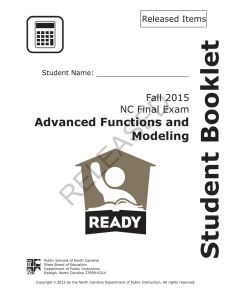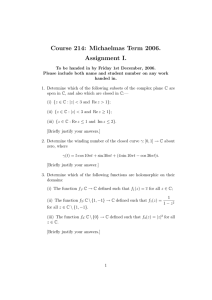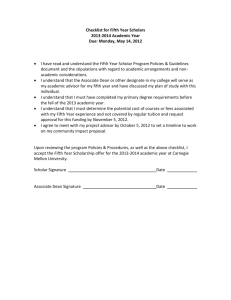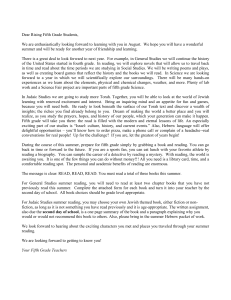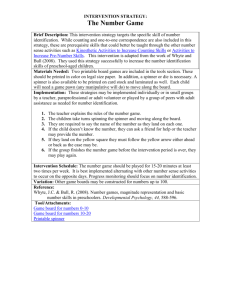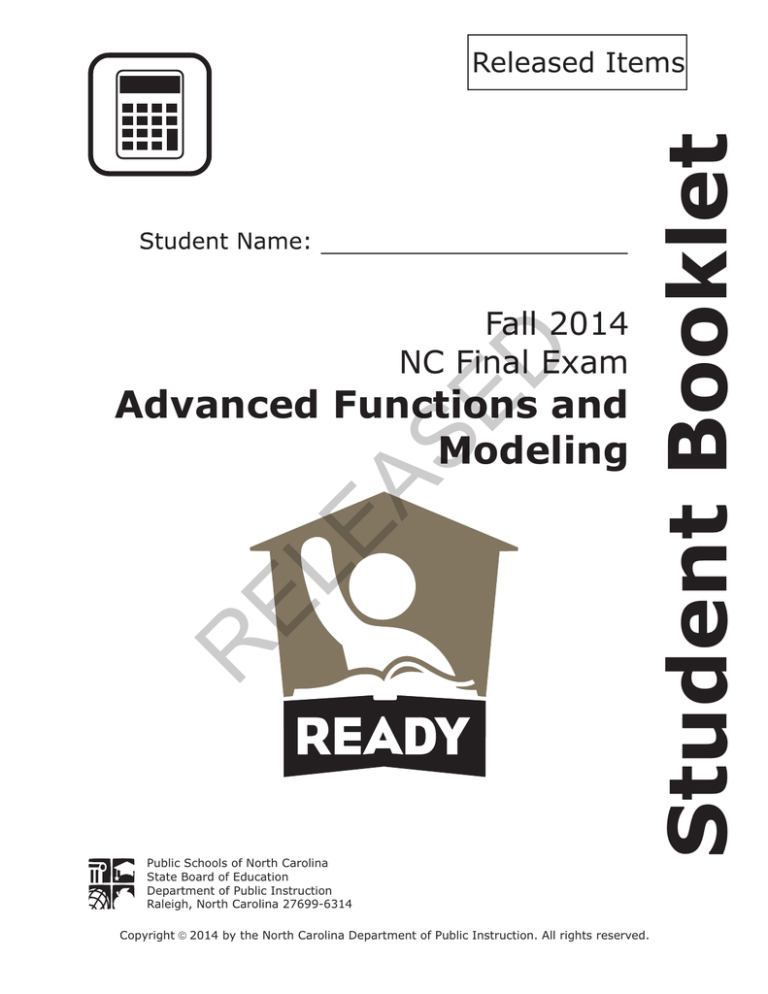
D
Fall 2014
NC Final Exam
R
EL
EA
SE
Advanced Functions and
Modeling
Public Schools of North Carolina
State Board of Education
Department of Public Instruction
Raleigh, North Carolina 27699-6314
Copyright ã 2014 by the North Carolina Department of Public Instruction. All rights reserved.
Student Booklet
Released Items
ADVANCED FUNCTIONS AND MODELING — RELEASED ITEMS
3.5 to 20.5
B
4 to 20
C
4.5 to 19.5
D
5 to 19
D
A
7,125
B
10,200
C
14,250
D
14,850
EA
A
SE
The lifetime of a particular type of car tire is normally distributed. The mean
lifetime is 50,000 miles, with a standard deviation of 5,000 miles. Of a random
sample of 15,000 tires, how many of the tires are expected to last for between
45,000 and 55,000 miles?
EL
2
Suppose the function H(t) = 8.5sin(0.017t – 1.35) + 12 models the hours of
sunlight for a town in Alaska, where t = 1 is the first day of the year. Based on the
function, what is the approximate range of daylight hours for the town?
R
1
1
Go to the next page.
ADVANCED FUNCTIONS AND MODELING — RELEASED ITEMS
The frequency table below shows the number of runners in specific age groups for
a certain race.
Age Group
Number of
Runners
0–10
11–20
D
21–30
31–40
SE
41–50
51–60
EA
61–70
71–80
EL
81–90
What is the shape of the distribution?
A
uniform
B
skewed right
C
skewed left
D
normal
R
3
2
Go to the next page.
ADVANCED FUNCTIONS AND MODELING — RELEASED ITEMS
A spinner labeled 1 to 9 gives each of the numbers 2, 5, 7, and 9 a 3 chance of
20
being landed upon. The chance of landing on each of the other five numbers is
equal. If the spinner is spun 1,000 times, which choice is the most likely outcome
for the 1,000 spins?
A
1
2
3
4
5
6
7
8
9
Number of
Occurrences
110
112
111
111
109
112
112
111
112
Number on
Spinner
1
2
3
Number of
Occurrences
82
148
78
EL
C
4
5
6
7
8
9
80
149
79
151
81
152
EA
B
SE
D
Number on
Spinner
Number on
Spinner
1
2
3
4
5
6
7
8
9
Number of
Occurrences
120
122
100
103
108
126
113
104
104
Number on
Spinner
1
2
3
4
5
6
7
8
9
Number of
Occurrences
121
100
119
120
102
120
98
121
99
R
4
D
3
Go to the next page.
ADVANCED FUNCTIONS AND MODELING — RELEASED ITEMS
79,833,600
B
1,209,600
C
604,800
D
362,880
D
A
The probability that it will rain on Saturday is 2 . The probability that the
SE
3
temperature on Saturday will reach 100°F is 4 . The probability that it will rain or
9
reach 100°F on Saturday is 4 . What is the probability it will rain and reach 100°F
on Saturday?
A
14
45
B
16
45
C
24
45
D
26
45
EA
5
EL
6
A group of 12 people need to form a line. The line will consist of exactly 9 of the
people. Person X and Person Y have to be either third or fourth in line. How many
different orders are possible?
R
5
4
Go to the next page.
ADVANCED FUNCTIONS AND MODELING — RELEASED ITEMS
7
A manufacturing plant produces a special kind of lightbulb.
Each lightbulb produced has a 0.040 probability of being defective.
Five lightbulbs are chosen at random from the production line.
B
0.016
C
0.018
D
0.020
SE
0.014
What is the meaning of the base of the function y = –log(x)?
As y decreases by 1, x increases by a factor of 10.
B
As y decreases by 1, x increases by 10.
C
As y increases by 1, x increases by a factor of 10.
D
As y increases by 1, x increases by 10.
EL
EA
A
R
8
A
D
To the nearest thousandth, what is the probability that exactly two of the
five bulbs will be defective?
5
Go to the next page.
ADVANCED FUNCTIONS AND MODELING — RELEASED ITEMS
The graph of y = ax is shown below.
y
+10
+8
+6
+4
–4
–3
–2
–1
0
+1
+2
+4
+3
+5
x
SE
–5
D
+2
–2
EA
–4
–6
–8
EL
–10
Which choice is closest to loga3?
A
0.9
B
2.1
C
3.2
D
4.8
R
9
6
Go to the next page.
ADVANCED FUNCTIONS AND MODELING — RELEASED ITEMS
10
A piecewise function is shown below.
2
2 x 5x 10 for 4 x 3
h(x)
for 3 x 5
2x 3p
1
3
C
25
3
D
34
3
SE
B
EA
10
3
1
The equation y 4.7x 6 is graphed on the coordinate plane. How does increasing
the denominator of the exponent transform the graph?
The transformed graph will approach a horizontal asymptote while the
original graph will not.
B
The transformed graph will not approach a horizontal asymptote while the
original graph will.
C
The transformed graph will go to slower than the original graph as the
value of x gets larger.
D
The transformed graph will go to faster than the original graph as the
value of x gets larger.
EL
A
R
11
A
D
For what value of p will the function be continuous?
7
Go to the next page.
ADVANCED FUNCTIONS AND MODELING — RELEASED ITEMS
Which function correctly represents the graph below?
EL
EA
SE
D
y
A
B
C
D
x
y sin x 4
3
y cos x 4
3
y cos x 4
3
R
12
y sin x 4
3
8
Go to the next page.
ADVANCED FUNCTIONS AND MODELING — RELEASED ITEMS
Which function has an amplitude that is twice the size and a period that is
three times the size of the function y 3 cos x 1 2 ?
4
B
C
A
182 miles
B
200 miles
C
238 miles
D
249 miles
EA
A plane takes off and travels at an angle of 40° north of east at 110 mph for
2 hours. It then adjusts its path to head 10° west of north and travels in that
direction for half an hour at a speed of 100 mph. Approximately how far away is
the plane from its starting point?
EL
14
y 3 cos 3x 1 3
2
4
y 6 cos 3x 1 3
4
y 3 sin x 3 1
2
12
SE
D
y 6 sin x 3 1
12
D
A
R
13
9
Go to the next page.
ADVANCED FUNCTIONS AND MODELING — RELEASED ITEMS
15
Which statement is true about the fifth terms of the two sequences below?
an 3n 2 6
bn 3(bn 1 6); b1 10
B
The fifth term of the explicit sequence exceeds the fifth term of the recursive
sequence by 63.
C
The fifth term of the recursive sequence exceeds the fifth term of the explicit
sequence by 21.
D
The fifth term of the explicit sequence exceeds the fifth term of the recursive
sequence by 21.
SE
D
The fifth term of the recursive sequence exceeds the fifth term of the explicit
sequence by 63.
EA
Which statement is true about the series shown below?
4 2 1 1 1 . . .
2
The series converges because r 1.
B
The series diverges because r 1 .
C
The series converges because r 1 .
D
The series diverges because r 1 .
EL
A
4
R
16
A
10
Go to the next page.
ADVANCED FUNCTIONS AND MODELING — RELEASED ITEMS
What is the explicit form of the equation an an 1 2(n 1); a1 1 ?
an 2n 1
B
an n 2 n 1
C
an n 2 2n 2
D
an 2n 2 2n 1
EL
EA
SE
D
A
R
17
11
Go to the next page.
ADVANCED FUNCTIONS AND MODELING — RELEASED ITEMS
This is the end of the Advanced Functions and Modeling Released Items.
Directions:
1. Look back over your answers for the test questions.
2. Make sure all your answers are entered on the answer sheet. Only what is
entered on your answer sheet will be scored.
3. Put all of your papers inside your test book and close the test book.
D
4. Place your calculator on top of the test book.
SE
5. Stay quietly in your seat until your teacher tells you that testing is
finished.
R
EL
EA
6. Remember, teachers are not allowed to discuss items from the test with
you, and you are not allowed to discuss with others any of the test
questions or information contained within the test.
12
A D V A N C E D F U N C T I O N S A N D M O D E L I N G — R E L E A S E D I T E M S
Advanced Functions and Modeling
RELEASED Items1
Fall 2014
Answer Key
Type2
Key
Percent Correct3
Standard
1
MC
A
50%
1.01.a
2
MC
B
48%
1.02.d
3
MC
B
37%
1.02.e
4
MC
B
39%
5
MC
B
6
MC
A
7
MC
8
MC
SE
1.03.c
1.03.b
20%
1.03.a
EA
21%
19%
1.03.f
A
45%
2.01.b
EL
A
MC
B
29%
2.01.a
MC
B
42%
2.02.a
MC
C
34%
2.03.b
MC
A
43%
2.04.a
13
MC
A
29%
2.04.b
14
MC
D
23%
2.04.c
15
MC
C
37%
2.05.d
16
MC
A
30%
2.05.c
17
MC
B
17%
2.05.d
10
11
12
R
9
D
Item Number
1
A D V A N C E D F U N C T I O N S A N D M O D E L I N G — R E L E A S E D I T E M S
1
These released items were administered to students during a previous test administration. This
sample set of released items may not reflect the breadth of the standards assessed and/or the
range of item difficulty found on the NC Final Exam. Additional items may be reviewed at
http://www.ncpublicschools.org/accountability/common-exams/released-forms/. Additional
information about the NC Final Exam is available in the Assessment Specification for each exam
located at http://www.ncpublicschools.org/accountability/common-exams/specifications/.
2
This NC Final Exam contains only multiple-choice (MC) items.
3
R
EL
EA
SE
D
Percent correct is the percentage of students who answered the item correctly during the
Spring 2014 administration.
2
A D V A N C E D F U N C T I O N S A N D M O D E L I N G — R E L E A S E D I T E M S
Standard Descriptions
This NC Final Exam is aligned to the 2003 Standard Course of Study. Only standard descriptions
addressed by the released items in this booklet are listed below. A complete list of standards
may be reviewed at http://maccss.ncdpi.wikispaces.net/High+School.
1.01.a
Create and use calculator-generated models of linear, polynomial, exponential, trigonometric,
power, and logarithmic functions of bivariate data to solve problems: Interpret the constants,
coefficients, and bases in the context of the data.
D
1.02.d
Summarize and analyze univariate data to solve problems: Recognize, define, and use the
normal distribution curve.
SE
1.02.e
Summarize and analyze univariate data to solve problems: Interpret graphical displays of
univariate data.
EA
1.03.a
Use theoretical and experimental probability to model and solve problems: Use addition and
multiplication principles.
1.03.b
Use theoretical and experimental probability to model and solve problems: Calculate and apply
permutations and combinations.
EL
1.03.c
Use theoretical and experimental probability to model and solve problems: Create and use
simulations for probability models.
R
1.03.f
Use theoretical and experimental probability to model and solve problems: Apply the Binomial
Theorem.
2.01.a
Use logarithmic (common, natural) functions to model and solve problems; justify results: Solve
using tables, graphs, and algebraic properties.
2.01.b
Use logarithmic (common, natural) functions to model and solve problems; justify results:
Interpret the constants, coefficients, and bases in the context of the problem.
2.02.a
Use piecewise-defined functions to model and solve problems; justify results: Solve using tables,
graphs, and algebraic properties.
2.03.b
Use power functions to model and solve problems; justify results: Interpret the constants,
coefficients, and bases in the context of the problem.
3
A D V A N C E D F U N C T I O N S A N D M O D E L I N G — R E L E A S E D I T E M S
2.04.a
Use trigonometric (sine, cosine) functions to model and solve problems; justify results: Solve
using tables, graphs, and algebraic properties.
2.04.b
Use trigonometric (sine, cosine) functions to model and solve problems; justify results: Create
and identify transformations with respect to period, amplitude, and vertical and horizontal shifts.
2.04.c
Use trigonometric (sine, cosine) functions to model and solve problems; justify results: Develop
and use the law of sines and the law of cosines.
D
2.05.c
Use recursively-defined functions to model and solve problems: Determine whether a given
series converges or diverges.
R
EL
EA
SE
2.05.d
Use recursively-defined functions to model and solve problems: Translate between recursive and
explicit representations.
4

